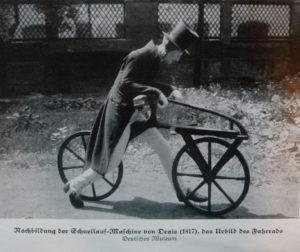Did you know that in the beginning the bicycle had neither pedals nor brakes?
Well yes. The ancestor of the first two-wheeled vehicle in history was presented in Paris on 6 April 1818 during the Paris Motor Show. The Draisine, or Draisine, was created as early as 1816 by the German inventor Karl Christian Ludwig Drais von Sauerbronn, from which he took the name.
Unlike the current bicycle, born a few decades later with the first transmission chain, the real “engine” of Draisine was the driver himself. Both to give the push, and to curb of course, while the novelty compared to previous and older models (including the first sketches and prototypes of Leonardo da Vinci) was in the addition of the front steering wheel, which was going to refine the previous model of the Count Mede de Sivrac, called Celeriferous.
Different and varied applications of this invention that, according to the inventor, had to serve as a means of daily transport instead of the most expensive horse. In reality, however, the lack of an alternative propulsive system compared to the kinetic energy of the driver, the medium had the most varied and different developments. It passed from the entertainment medium of the wealthy classes of the English bourgeoisie, called “Hobby Horse” (Fun horse), sport. Draisine was also called a railway service, mainly used for maintenance or logistics. The difference is in propulsion, as this version used either hand, pedal or motor movement since the mid-19th century.

Denis Johnson was the first to think of Drasina as a means of competition, even creating one of the first schools for Draisine in the world, which he himself baptized as “Pedestrian curricle”
(walking Buggy). The first race of Draisine was in 1819 and to win it was the German Semmler who managed to maintain a speed of 20 km/h to the finish, reached after 10 km of race.
A speed not of little account, considering the absence of paved roads at the time and the fact that the effort of the driver was not of little account, made by the way on seats not properly ergonomic. Imagine riding a bike, on a country road with holes and imperfections, dusty, and drag a wooden bike only with the aid, in acceleration and braking, only and exclusively of your feet. All for 10 km. Semmler took you 31 minutes.